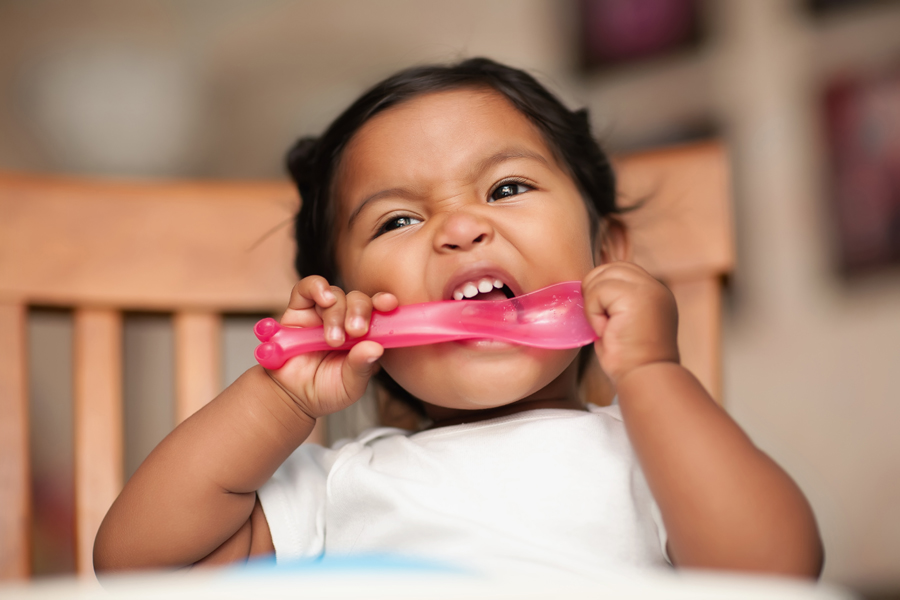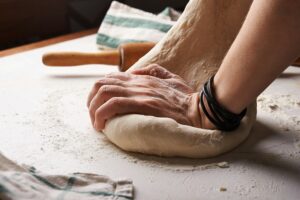Starting solids can be one of the most stressful times as a new parent. It sounds easy enough: I mean, just mash up some bananas and spoon it in their mouth, right? Sure. . . once you get the hang of it. The first step is determining whether your baby is ready. The American Academy of Pediatrics recommends starting solid food around 6 months, but sanctions starting any time between 4 to 6 months, depending on your baby. Can she sit up with strong neck control? Does she show interest when you bite into that juicy BLT? (Smart kid.) If so, she’s probably ready.
It’s important to remember that when your little one is starting solids, the bulk of their nutrition and sustenance will still come from your breast milk and/or formula until after 12-months-old. Starting solids is more about helping them learn to chew and swallow and to get used to new tastes and textures. So try to keep it fun—for both of you! This no-stress guide to starting solids—and a whole lot of laundry detergent—should help.
Related: Storing baby food just got a little easier
Starting solids: The basics

Introduce one food at a time. While this isn’t imperative for any health reason, waiting at least 1 to 2 days between starting new foods can help you zero in on the culprit if your baby has a bad or allergic reaction. By the time you get the hang of things—whether with your first babe or by baby number two—you may opt out of doing this, but it’s helpful at first, especially if your family has a history of food allergies.
Puree, blend, mash—or not. Baby food is less about what’s in the mix (if you’re up for it, it’s perfectly okay to share your healthy, multi-ingredient, well-spiced food with baby) than it is about texture. Baby led weaning is the idea that babies can and should feed themselves food in its natural texture from jump—as in, go ahead and hand over that whole wedge of watermelon (above)—but most folks subscribe to the idea that it’s better to puree, blend, or mash food into a smooth texture at first, even if just for a couple of weeks.
Babies all around the world are fed both ways and survive, so no judgements here! Just decide on your approach and, if you go with pureed foods, remember to keep graduating to chunkier textures every time baby masters what you’re feeding them. Start by adding a little water, breastmilk, or formula to achieve a very smooth consistency, then pull back as they get older. The goal is for them to be able to safely manage regular food by about 12-months-old.
Get in the mood. Try feeding your baby when he or she is generally happy and not completely starving or tired. Feed her a little breastmilk or formula first if needed. In fact, while we think of dinner as our “main” meal, sometimes breakfast or lunch (if it’s after naptime) can be a better time to try new foods.
Go with color! Mix it up and don’t give up if at first they don’t like something. Initially, my daughter’s dislike of avocados led to my declaration that it was time to move back to California, but I kept it around long enough and now avocado is one of her favorites. It’s said that it can take up to 12 tries or more for a child to accept a new food. (Sigh. Baby time.) While we know that can be frustrating—and hardly expect you to keep at it that long with every single food—we do hope that you’ll refrain from making assumptions before your child has even had the chance to develop a taste for whatever it is.
Don’t force him, or the schedule. If your baby turns his head away from the spoon, do not force him to eat. Try again at the next meal or the next day. Once the baby gets the concept of eating, you can transition to a routine of breakfast, lunch, and dinner, but this may take months. It’s okay!
 Cook in bulk. A little goes a long when you’re first starting solids; keep a portion or two in the refrigerator and freeze the rest. I used—and still do—the following essential food safe containers:
Cook in bulk. A little goes a long when you’re first starting solids; keep a portion or two in the refrigerator and freeze the rest. I used—and still do—the following essential food safe containers:
- The Onyx stainless steel ice cube tray is perfect for homemade applesauce and purees. Store the frozen cubes in labeled freezer bags; these were great to drop into oatmeal or when trying different combinations of food.
- For bigger portions, and freezing leftover portions of broth or sauces, I use the BPA-free, silicone Tovolo King Cube Ice Tray.
- The versatile Wean Green cubes (above) are also a favorite. Made from BPA-, PVC- and phthalate-free glass, these perfectly portioned, spill-proof containers are great for traveling or just being on-the-go around the neighborhood. You can also use them to freeze or reheat food.
Consider investing in a baby food maker. We’re not big on encouraging you to spend money on tools with a short kitchen lifespan unless they are life-changing and, well, if you’re 100% committed to only homemade baby food, a baby food maker may be just that. We love the One Step Baby Food Maker that we featured in this year’s Cool Mom Picks Ultimate Baby Shower Gift Guide sponsored by the maker, Baby Brezza. You put ingredients in, press a button, and the machine steams and purees for you. And don’t worry, we’ve been fans of this machine since before Baby Brezza was a trusted partner: We first featured it in 2011! If you’re trying to avoid plastic, we gave the newest model, the Glass One Step Baby Food Maker, a test run and loved it as much as the previous models.
Buck the rules. You do not have to start with rice cereal. The arsenic debate aside, there’s simply no reason you can’t start with a pureed vegetable like sweet potatoes. There’s even a WhiteOut Movement designed to encourage parents to move beyond nutritionally void rice cereal as a first food. If there’s no history of food allergies in your family, you may even mix the once-taboo peanuts, eggs, and berries into your baby’s diet right from the start. In fact, some experts encourage it!
The only rule that still stands no matter what relates to honey: Delay feeding your baby honey until after her first birthday due to the risk of botulism. And as always, talk with your pediatrician first if you have any questions or concerns.
Related: Healthy, low-sugar baby cookie recipes you can feel good sharing with your baby or toddler.
Starting solids: Resources and recipes

Knowledge and confidence: These are the two guiding principles of the enormously helpful, non-judgmental site, baby gooroo. Founded by a nurse and lactation consultant over 25 years ago, baby gooroo’s section on starting solids covers the basic questions (“How much solid food does my baby need?”) and ones you may not have thought of (“Do I need to worry about nitrates in baby food?”).

Michelle and the other mamas at Baby FoodE have created a thorough and welcoming site for all your feeding questions. Check out the section called The Basics to read about everything from when and how to start solids, to how much to give and how to freeze baby food. Recipes are generous with cooking and feeding tips, and I love the inclusion of herbs and certain spices for when your baby is ready to be a little more adventurous, like this Sweet Potato and Strawberry Puree with Cinnamon and Farro (above).

It’s no secret that we’re big fans of Weelicious. Catherine’s baby food recipes–and the entire site–are a wealth of knowledge and deliciousness. If you are interested in feeding your baby protein, but are reluctant to introduce meat or fish, go with a high protein grain like quinoa. The Quinoa Banana Mash at Weelicious is a great starter recipe that includes the super grain, a little greek yogurt, and a touch of cinnamon. Oh, and don’t be scared: If you use our tutorial for how to cook quinoa, it’ll come out mild and even sweet tasting. Yes, for real.

Sometimes we just need someone to hand us a few recipes and tell us what to do (okay, a lot of times). When mealtime comes around, it’s nice to have a few fallbacks or even better, some healthy scratch meals in the fridge ready to go. That’s why I love the four Baby Food Favorites at Plump Pie Cooks. Colorful and nourishing, these four recipe combinations are simple and cover a wide range of just what our babies need: vitamin-rich veggies and fruit, along with protein and dairy.
 Already have a stash of pureed pears and peas in the fridge? Looking for some unconventional meal ideas for your baby? If so, delve into the sweet and savory combinations at Farm to Table Mama, like ger Fig, Pear and Carrot Puree (above). Plus, Patricia includes fun how-to videos for most of her recipes. Such great inspiration.
Already have a stash of pureed pears and peas in the fridge? Looking for some unconventional meal ideas for your baby? If so, delve into the sweet and savory combinations at Farm to Table Mama, like ger Fig, Pear and Carrot Puree (above). Plus, Patricia includes fun how-to videos for most of her recipes. Such great inspiration.

Shopping these days is harder than ever: organic, local, sustainable, WTH? The choices are endless and often overwhelming. I personally think that when starting solids, going organic whenever you can is best. Their little systems are still developing, so the fewer pesticides, the better. That said, sometimes I just can’t stomach paying that much money for organic bananas. If you’re unsure about buying organic, familiarize yourself with the EWG 2016 “Dirty Dozen” and “Clean Fifteen” lists, and see what feels right for your family.






